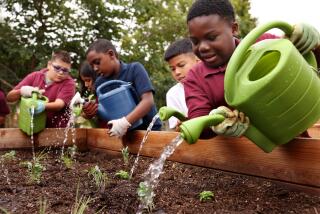BUENA PARK : This ‘Family’ Is a Study in Uniqueness
Felipe Guzman struggled to answer when asked his last name. Even the simplest questions can sometimes seem impossible for the sixth-grader from Mexico who speaks very little English.
Looking troubled and a bit scared, he turned to Francisco Diaz, who sat next to him.
“Como se llama?” Francisco translated, so Felipe would understand.
Since the beginning of the school year, the two have been a part of each other’s regular assignment. While Francisco helps Felipe learn English, Felipe in turn helps Francisco learn Spanish. During the past few months, the pair that started simply as classmates have become translators, teachers and friends.
“Sometimes he doesn’t understand a word, so I help him with it,” said Francisco, 11. “Besides, my mom is always telling me I have to improve my Spanish, so it is good practice.”
Felipe and Francisco are part of the “family” of students in Rooms 15 and 16 at Raymond Temple Elementary School, a special class devoted to stressing the uniqueness of children. Instead of separating students because of their different abilities, the school combines youngsters of all learning levels--including special education, non-English-speaking and intellectually gifted--in this unusual classroom.
In its fourth year now, the mixture has been so successful that the California School Boards Assn. has just awarded the class a first-place Golden Bell Award for its approach to teaching. The class was singled out of more than 200 schools. The teachers will receive the award Dec. 14 in San Francisco.
“It is really special,” said teacher Patti Purnell, whose 12 communicatively handicapped students are in the class. “They help each other out and learn to care for one another.”
Before 1988, a wall kept Purnell’s special education students in their own world. They would be mixed with students in “regular classrooms” like that of Joanne Brooks a few times a week. But this often left Purnell’s students secluded from the majority of the campus, so much so that they hardly ever made friends outside their own room.
After attending a seminar, Purnell and Brooks decided to put their classes together. Four years ago in September, the wall between Rooms 15 and 16 was knocked down and replaced with a movable divider.
Since then, the 40 or so students who refer to themselves as “the family” share almost everything from lessons in anatomy to compassion for those who are different.
“I like to work with the family,” said 12-year-old Ronnie Solorzano, standing before his classmates. “If someone is new, we reach out to them, and we also learn things we didn’t know.”
This year’s class is similar to past years’. Out of 42 students, 12 are special education, two speak no English and another 10 have some English skills. In addition, two students must go to a resource specialist for help in certain learning areas, and four are academically gifted. The remainder have no special needs. Many of the class’s graduates stay in touch with the teachers, and some help other students moving up the ranks from the sixth grade to junior high.
In the past, the students have become so attached to the class that letting go can be hard, says Brooks, who has been teaching since 1957. The last day of school is especially difficult, she says. “I mean to tell you there is not a dry eye in the place. It is awful. We just blubber.”
More to Read
Sign up for Essential California
The most important California stories and recommendations in your inbox every morning.
You may occasionally receive promotional content from the Los Angeles Times.










